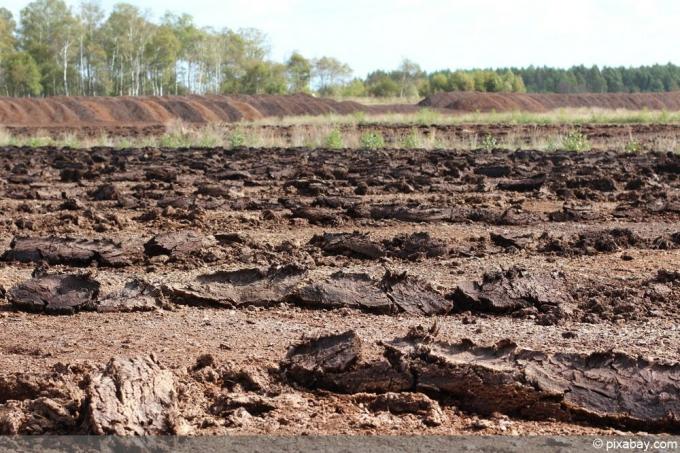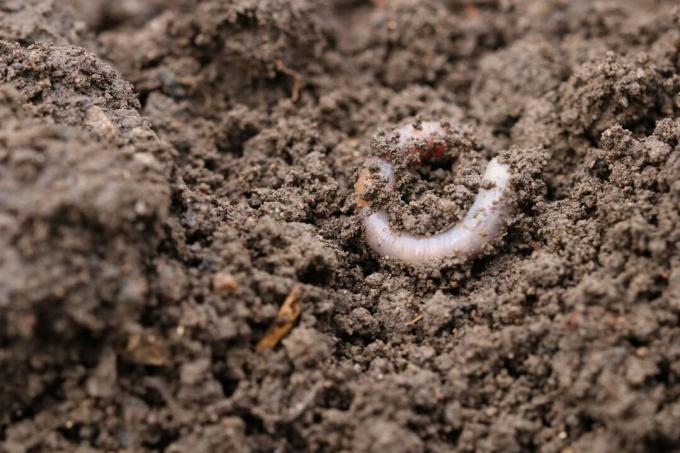

Table of contents
- What is raised bog peat anyway?
- Properties of raised bog peat
- Why is peat used?
- Self-mixed plant substrate
- The criticisms of environmentalists
- Peat-Reduced Products
- What does a substitute have to offer?
- Peat-free soil from the trade
- alternatives to peat
- Use peat wisely?
The criteria for purchasing decisions have changed. In addition to the price and properties of the product, environmental aspects are also playing an increasingly important role. Most commercially available potting soil is no longer regarded as harmless. It contains large amounts of raised bog peat. Raised bogs, however, fulfill an ecological function and should remain untouched. But the preference for peat persists. Is he really irreplaceable?
What is raised bog peat anyway?
Bogs are water-saturated and oxygen-poor landscapes. Under these circumstances, microorganisms can only very slowly decompose the dead plant material into its components. The only partially decomposed plant material accumulates over time and forms the peat. A raised bog no longer has a connection to the groundwater and is only fed with moisture from precipitation.
The first stages of decomposition produce white peat, which is actually light brown. Plant remains can still be seen in it. Black peat is the last stage of decomposition that still has the properties of loose soil. Because dried peat is combustible, it was used extensively for heating in the past. It is therefore still common today to classify peat according to its calorific value. The higher the value, the more the plant material has decomposed.
Properties of raised bog peat
White peat is mostly used for potting soil because it has a coarser structure than black peat. As a result, the plant substrate is looser. It also contains black peat less frequently. Both types of peat are nutrient-poor and acidic. Their pH is so low:
- White peat has a value between 3 and 4
- Black peat has a value between 5 and 6
Why is peat used?
All plants need nutrients for their growth and mostly a not too acidic environment. Torf has neither to offer. It is therefore surprising why it has become so widespread. However, it has been cheap for decades, which makes it attractive for retailers. Added to this is the effortless dismantling as well as simple packaging and transport. The following reasons are given for its use:
- good starting material due to uniform composition
- its structural stability gives plant roots support
- can store and release water and nutrients
- is largely free of pathogens and seeds
- the loose structure offers good oxygen supply

A lack of nutrients and a low pH value do not pose an unsolvable problem for industry. Nutrients are simply added in the desired composition and concentration. And by adding lime, the acid is neutralized.
A notice:
The mining companies do not provide any financial compensation for the destruction of the raised bogs.
Self-mixed plant substrate
When you mix your own soil at home using peat, your plants can benefit from its physical properties such as looseness and structural stability. But you also have to find a solution for the "acidic" problem and the lack of nutrients yourself. This requires the use of additional materials or additional fertilizer and lime to neutralize the acid. Since none of us are chemical laboratory assistants, an optimal composition can hardly be achieved exactly.
The criticisms of environmentalists
It takes about a thousand years for peat to form from plant remains. The peat bog layer grows by only one millimeter a year. On the other hand, we humans are record holders when it comes to speed. Although the moor is growing, it is not able to compensate for the degradation in a timely manner. As a result, raised bog areas are shrinking and disappearing forever.
But why is the bog so important? These are the reasons:
- the moor areas make up about 3% of the earth's surface
- but they store 30% of the earth's CO2
- this is an important contribution to climate protection
- Bogs store water
- they only slowly release it into the groundwater
- that counteracts flooding
- the moor is a valuable habitat
- plants and animals specialized in it can only exist there
A notice:
Peat is mined cheaply, especially in Eastern Europe. He has to travel the long way to us on trucks. In the process, together with other environmentally harmful substances, a lot of climate-damaging CO2 gas is emitted.
Peat-Reduced Products
There is now soil on the market that is offered with a reduced peat content. This should also satisfy environmentally conscious buyers and encourage them to buy. In fact, the amount of peat has been reduced, but the amount of peat it contains is still enormous. Instead of 100%, it's "only" 80%. Everyone should decide for themselves whether they consider this reduction to be sufficient or whether they regard the whole thing as a pure marketing move.
What does a substitute have to offer?

Alternative ingredients for potting soil should of course be environmentally friendly and sustainable themselves. In addition, they should in particular offer the properties for which peat is so valued. This includes the ability to provide a loose potting soil. Furthermore, a nutrient-poor soil is required for the cultivation. For plants that prefer acidic soil, the lower pH value must be achieved in other ways.
Peat-free soil from the trade
It also exists, albeit with a modest market share at the moment: the completely peat-free potting soil. Their composition consists of the following natural materials that make peat superfluous:
- bark humus
- Fibers from wood, coconut, Chinese reed or hemp
- with additions of lava granules, sand or clay minerals
Tip:
Cultivation areas of coconut palms are far away from us. The long transport route is anything but climate-friendly. Environmentally conscious gardeners also avoid potting soil that contains this substance.
alternatives to peat
Potting soil does not always have to be obtained from the garden center, which is expensive and time-consuming. Anyone can mix up a good plant substrate at home. The composition depends on the intended use. However, many recommendations require the addition of peat. However, depending on the function the peat is to fulfill, an alternative material can be used.
- a portion of sand loosens up solid soil
- Xylitol or bark mulch are also suitable for this
- Compost also brings in plenty of nutrients
- Grape ester lowers pH
- alternatively special, acidic compost
- Expanded clay supplied with water and aerated
A nutrient-poor potting soil is usually required for the cultivation. This can be achieved by adding perlite and coconut humus.
Tip:
Don't just look for peat-free substrate. Other products such as small seed pots can also be made from peat.
Use peat wisely?
The recommendation here could be to use peat only in exceptional cases and only in small quantities. But given that peat is replaceable, there is no reason to. Of course we can and may use up peat that has already been bought. Rhododendrons and azaleas, for example, will benefit from it as they like acidic soil.
 garden editorial
garden editorial I write about everything that interests me in my garden.
Learn more about floor care

Digging up the garden: 13 tips for lawns and beds
Whether it makes sense to dig up beds or lawns is discussed in different ways. Once you have decided on this measure, our tips will help you to organize work in the garden effectively.

Pine bark: suitable for which plants?
Pine bark is a type of mulch that is gaining popularity among many garden owners due to its color and properties. Before purchasing, the question often arises as to which plants the bark mulch is suitable for. This question is justified because of the origin of the pine.

Which soil to choose for elephant foot?
The right substrate is crucial for the elephant's foot and should therefore be chosen well. Read here which soil is best suited for the Beaucarnea recurvata!

Expanded clay as a water reservoir: The alternative to earth?
Expanded clay is known to many as a substrate for hydroponics or as drainage in pots. Due to its properties, the clay granulate is suitable as a substrate in many different areas and can replace soil. The granules have long been an indispensable basis for green roofs.

Potting soil: Mix the potting soil yourself
Potting soil has to meet special requirements. It can therefore often make sense to mix potting soil yourself. This comes with several advantages. But what do you have to pay attention to? The guide below shows how to do it.

pH value in the soil: 15 tips for measuring & regulating
If the pH of the garden/plant soil is suboptimal, this can lead to serious plant damage. We show what options there are for measuring and regulating.
